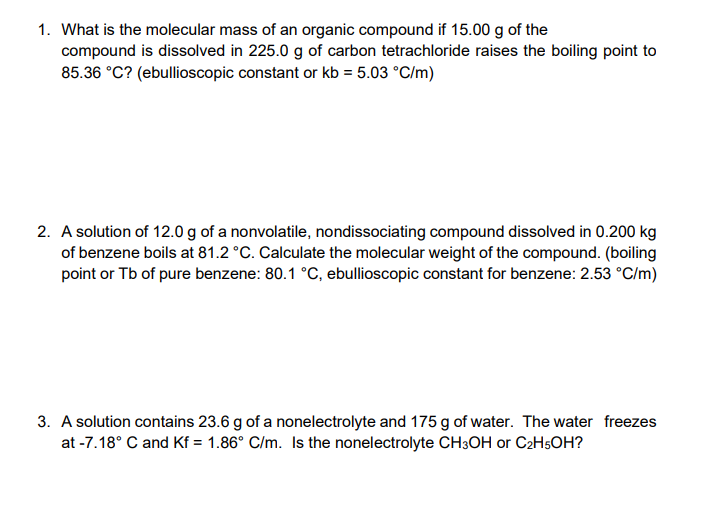. A solution of 12.0 g of a nonvolatile, nondissociating compound dissolved in 0.200 kg of benzene boils at 81.2 °C. Calculate the molecular weight of the compound. (boiling point or Tb of pure benzene: 80.1 °C, ebullioscopic constant for benzene: 2.53 °C/m) . A solution contains 23.6 g of a nonelectrolyte and 175 g of water. The water freezes at -7.18° C and Kf = 1.86° C/m. Is the nonelectrolyte CH3OH or C2H5OH?
. A solution of 12.0 g of a nonvolatile, nondissociating compound dissolved in 0.200 kg of benzene boils at 81.2 °C. Calculate the molecular weight of the compound. (boiling point or Tb of pure benzene: 80.1 °C, ebullioscopic constant for benzene: 2.53 °C/m) . A solution contains 23.6 g of a nonelectrolyte and 175 g of water. The water freezes at -7.18° C and Kf = 1.86° C/m. Is the nonelectrolyte CH3OH or C2H5OH?
Chemistry: An Atoms First Approach
2nd Edition
ISBN:9781305079243
Author:Steven S. Zumdahl, Susan A. Zumdahl
Publisher:Steven S. Zumdahl, Susan A. Zumdahl
Chapter10: Properties Of Solutions
Section: Chapter Questions
Problem 54E: At a certain temperature, the vapor pressure of pure benzene (C6H6) is 0.930 atm. A solution was...
Related questions
Question
ANS 2-3

Transcribed Image Text:1. What is the molecular mass of an organic compound if 15.00 g of the
compound is dissolved in 225.0 g of carbon tetrachloride raises the boiling point to
85.36 °C? (ebullioscopic constant or kb = 5.03 °C/m)
2. A solution of 12.0 g of a nonvolatile, nondissociating compound dissolved in 0.200 kg
of benzene boils at 81.2 °C. Calculate the molecular weight of the compound. (boiling
point or Tb of pure benzene: 80.1 °C, ebullioscopic constant for benzene: 2.53 °C/m)
3. A solution contains 23.6 g of a nonelectrolyte and 175 g of water. The water freezes
at -7.18° C and Kf = 1.86° C/m. Is the nonelectrolyte CH3OH or C2H5OH?
Expert Solution
This question has been solved!
Explore an expertly crafted, step-by-step solution for a thorough understanding of key concepts.
Step by step
Solved in 2 steps with 2 images

Knowledge Booster
Learn more about
Need a deep-dive on the concept behind this application? Look no further. Learn more about this topic, chemistry and related others by exploring similar questions and additional content below.Recommended textbooks for you

Chemistry: An Atoms First Approach
Chemistry
ISBN:
9781305079243
Author:
Steven S. Zumdahl, Susan A. Zumdahl
Publisher:
Cengage Learning

Chemistry & Chemical Reactivity
Chemistry
ISBN:
9781133949640
Author:
John C. Kotz, Paul M. Treichel, John Townsend, David Treichel
Publisher:
Cengage Learning

Chemistry & Chemical Reactivity
Chemistry
ISBN:
9781337399074
Author:
John C. Kotz, Paul M. Treichel, John Townsend, David Treichel
Publisher:
Cengage Learning

Chemistry: An Atoms First Approach
Chemistry
ISBN:
9781305079243
Author:
Steven S. Zumdahl, Susan A. Zumdahl
Publisher:
Cengage Learning

Chemistry & Chemical Reactivity
Chemistry
ISBN:
9781133949640
Author:
John C. Kotz, Paul M. Treichel, John Townsend, David Treichel
Publisher:
Cengage Learning

Chemistry & Chemical Reactivity
Chemistry
ISBN:
9781337399074
Author:
John C. Kotz, Paul M. Treichel, John Townsend, David Treichel
Publisher:
Cengage Learning


Chemistry
Chemistry
ISBN:
9781305957404
Author:
Steven S. Zumdahl, Susan A. Zumdahl, Donald J. DeCoste
Publisher:
Cengage Learning

Chemistry: Principles and Practice
Chemistry
ISBN:
9780534420123
Author:
Daniel L. Reger, Scott R. Goode, David W. Ball, Edward Mercer
Publisher:
Cengage Learning